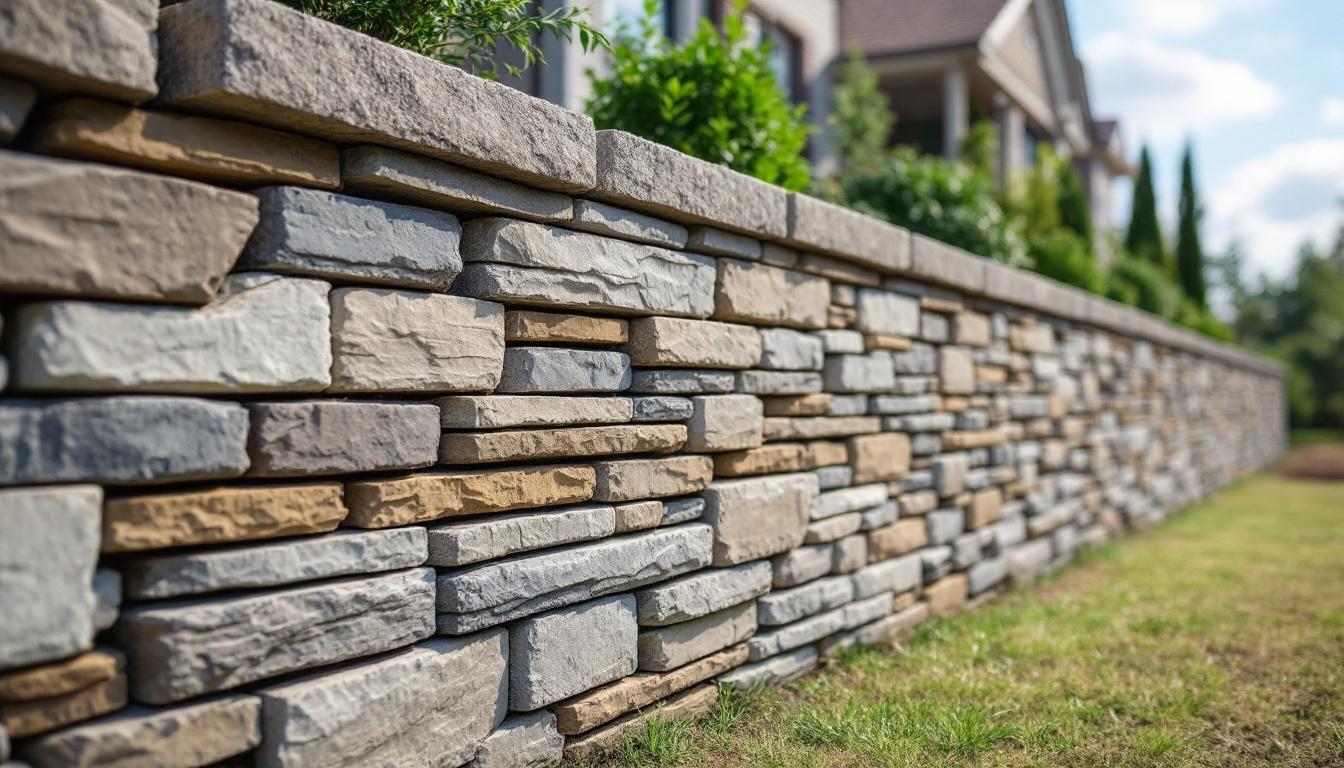When we think about outdoor spaces, retaining walls often play a vital role in both function and design. These structures help manage soil erosion and create level areas in sloped landscapes. Choosing the right retaining wall material is essential for ensuring longevity and visual appeal.
From sturdy stone retaining walls to versatile concrete options and charming timber designs, each material comes with its own set of benefits. Weather resistance, cost-effectiveness, and maintenance needs can vary significantly between them. In this text, we’ll explore the best materials for retaining wall construction and installation, helping you make an informed choice for your next landscaping project.
Overview of Retaining Wall Materials
We examine key materials used in retaining wall construction. Each material serves distinct purposes and offers various benefits.
- Concrete Blocks: Concrete block retaining walls deliver durability and require low maintenance. They’re an economical choice for homeowners and offer flexibility in design.
- Natural Stone: Stone retaining walls, including granite and limestone, provide aesthetic appeal and strength. These materials suit high-end properties, enhancing landscaping while preventing soil erosion.
- Timber: Timber retaining walls, often used for residential properties, offer affordability and ease of installation. While visually appealing, they may have a shorter lifespan compared to stone or concrete options.
Selecting the best retaining wall material hinges on durability, weather resistance, and local conditions. For effective retaining wall installation, proper drainage integration and material selection is crucial to prevent soil pressure issues.
Types of Retaining Wall Materials
Selecting the right retaining wall material is crucial for lasting durability and aesthetic appeal. Here are the key types of materials we commonly use in our projects.
Concrete
Concrete retaining walls provide excellent durability and affordability. These walls can be customised with various finishes, fitting seamlessly into modern landscapes. While they crack over time without proper drainage, their longevity outweighs this concern. We specialise in reinforced concrete retaining walls, ensuring integration with drainage systems to prevent foundation damage. Concrete suits large-scale projects and urban properties.
Natural Stone
Natural stone offers a classic look and exceptional durability for high-end properties. Stone retaining walls require skilled installation due to their high material and labour costs. Although they demand an initial investment, they provide long-term stability and low maintenance.
Timber
Timber is a budget-friendly option for retaining wall construction, ideal for smaller gardens and temporary landscaping solutions. Quick installation makes them attractive for cost-conscious homeowners. But, timber retaining walls have a shorter lifespan, making them vulnerable to moisture and termites. We can enhance these installations with protective sealing for longer-lasting functionality.
Steel
Steel retaining walls are strong and provide a modern aesthetic for various projects. They resist corrosion when treated properly and are particularly useful in commercial applications. The versatility of steel allows for slim designs, reducing the footprint while maintaining strength.
Block
Concrete block retaining walls offer versatility and robust support. They simplify installation while allowing for varied designs that cater to aesthetic preferences. These walls are weather-resistant, suitable for diverse climates, including Ontario’s harsh conditions. We provide expert advice on the best block configurations for effective drainage and enhanced stability.
For tailored solutions in Guelph, Kitchener, and surrounding areas, reach out to us for expert advice on the right retaining wall materials for your project.
Factors to Consider When Choosing Materials

Choosing the right retaining wall materials ensures durability and effectiveness.
Durability & Weather Resistance
Prioritise materials that withstand harsh Canadian weather. Concrete retaining walls offer excellent durability and low maintenance. Stone retaining walls, like granite, provide natural strength. Timber retaining walls may suit budgets but often face shorter lifespans.
Cost vs. Long-Term Investment
Analyse both initial installation costs and long-term maintenance. While concrete blocks might cost more upfront, their longevity makes them an economical choice over time. Timber retaining walls can lower initial costs, yet require replacement sooner, affecting overall value.
Aesthetic Appeal & Landscaping Fit
Consider how materials complement outdoor designs. Stone retaining walls enhance gardens with elegance. Concrete retaining walls can be styled for modern aesthetics. Understanding personal preferences helps in selecting the best retaining wall material for unique landscapes.
Drainage & Soil Stability
We integrate proper drainage solutions during retaining wall construction. Effective drainage prevents water buildup, safeguarding wall integrity. Using Winstorm‘s drainage solutions keeps soil stable, supporting the retaining wall‘s structure and longevity.
Which Retaining Wall Material is Best for Your Needs?
Selecting the right retaining wall material impacts durability, aesthetics, and functionality. We consider three primary options: concrete, stone, and timber.
Concrete Retaining Walls
Concrete blocks provide a modern, durable solution. These low-maintenance walls withstand harsh weather conditions, making them suitable for properties in Ontario’s climate. Concrete’s longevity offers a solid return on investment even though a higher initial cost.
Stone Retaining Walls
Natural stone walls combine aesthetic appeal with strength. We often use granite or limestone for high-end properties. Stone’s natural beauty enhances gardens while providing excellent stability. These walls excel in erosion control, especially on sloped yards.
Timber Retaining Walls
Timber walls present an affordable option for residential properties. They’re easy to install but may require more maintenance over time. Proper sealing and drainage are crucial for longevity, as timber can deteriorate from moisture exposure.
Choosing the Best Material
Selecting the best retaining wall material hinges on various factors:
- Durability: Concrete offers superior longevity, while timber needs regular upkeep.
- Aesthetics: Stone enhances visual appeal, fitting well into landscaped areas.
- Cost: Timber provides a budget-friendly alternative, suitable for smaller projects.
Proper drainage integration during retaining wall installation prevents water pooling, protecting wall integrity. Whether we choose concrete, stone, or timber, our focus remains on creating durable retaining walls suited to your unique needs.
Installation and Maintenance Considerations
Prioritise effective installation and maintenance when constructing retaining walls. Proper drainage integration prevents water pooling, which can weaken wall structures. Retaining wall installation must allow for adequate soil support around walls, particularly in areas with challenging Ontario soils.
Installation Tips:
- Select Suitable Materials: Choose from concrete block retaining walls for durability, stone retaining walls for aesthetics, or timber retaining walls for affordability.
- Ensure Proper Alignment: Walls must sit level to support soil effectively and resist shifting.
- Incorporate Drainage Solutions: Use perforated pipes and gravel behind walls to help water flow.
Maintenance Practices:
- Inspect Regularly: Check for cracks or leaks at least twice a year, especially after heavy rains.
- Clean Drainage Systems: Clear debris from drainage systems to maintain effective water flow.
- Repair Promptly: Address issues immediately to prevent structural damage or erosion.
Following these guidelines ensures retaining walls remain strong, functional, and visually appealing.
Retaining Wall Costs – What to Expect?
We understand the costs associated with retaining wall construction can vary significantly based on material choice and installation method. The primary factors affecting the budget include material costs, labour, permits, and the complexity of the project.
Installation Process
We see two main installation options: DIY and professional installation. DIY installation costs fewer labour fees but may require permits, especially for larger projects. Professional installation, while more expensive, ensures proper drainage and structural integrity, crucial for retaining wall success. Hiring experienced retaining wall contractors can prevent costly errors.
Maintenance Tips
We recommend selecting durable retaining walls that minimise upkeep over time. Concrete retaining walls require less maintenance compared to timber retaining walls, which may need frequent sealing and replacement. Regular inspections for cracks or shifts in the soil prevent costly repairs. Implementing proper drainage solutions during installation also enhances longevity and reduces maintenance efforts.
Conclusion
A well-built retaining wall not only enhances the landscape but also ensures stability and long-term functionality. Choosing the right material—whether concrete for durability, stone for aesthetics, or timber for affordability—depends on your property’s needs and conditions. Proper installation, drainage integration, and regular maintenance are key to maximizing your investment. If you’re planning a retaining wall project in Guelph, Kitchener, or surrounding areas, Winstorm offers expert guidance and high-quality solutions tailored to your landscape.
Frequently Asked Questions
What materials are commonly used for retaining walls?
Common materials include concrete, natural stone (like granite and limestone), and timber. Each material has its advantages in terms of durability, maintenance, and aesthetic appeal, making them suitable for different projects and budgets.
Why is material selection important for retaining walls?
Choosing the right material affects the wall‘s durability, maintenance needs, and visual appeal. It ensures the wall can withstand local weather conditions and soil pressures while complementing the surrounding landscape.
How do concrete retaining walls compare to timber walls?
Choosing the right material affects the wall‘s durability, maintenance needs, and visual appeal. It ensures the wall can withstand local weather conditions and soil pressures while complementing the surrounding landscape.
How do concrete retaining walls compare to timber walls?
Concrete walls are durable, low-maintenance, and suited for harsh weather, making them a long-term investment despite higher initial costs. Timber walls are more affordable and easier to install but have a shorter lifespan and require more maintenance.
What is the best material for a retaining wall?
The best material depends on durability, cost, and aesthetics:
- Concrete Blocks – Strong, long-lasting, and low maintenance.
- Natural Stone – Aesthetic and durable but more expensive.
Timber – Affordable and easy to install but has a shorter lifespan.
What are the typical costs involved in building a retaining wall?
Costs can vary widely based on material choice, labour, permits, and project complexity. DIY options may save on labour costs, but professional installation usually guarantees better drainage and structural integrity, albeit at a higher price.
Which retaining wall is best for sloped yards?
Concrete block and natural stone walls are ideal for sloped yards due to their strength and stability. Reinforced walls with proper drainage prevent soil erosion.

